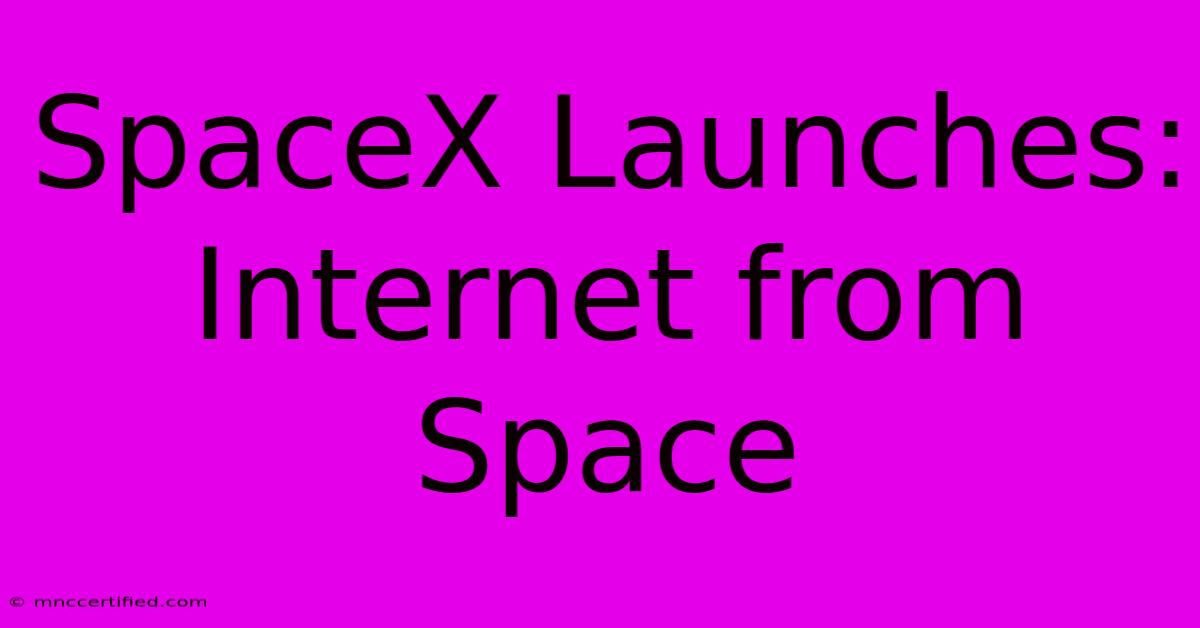SpaceX Launches: Internet From Space

Table of Contents
SpaceX Launches: Bringing Internet from Space to the World
SpaceX, the innovative aerospace company founded by Elon Musk, has revolutionized the space industry with its ambitious goal of colonizing Mars. But beyond its interplanetary ambitions, SpaceX is also making waves in the world of internet connectivity with its Starlink satellite constellation.
This ambitious project promises to deliver high-speed, low-latency internet access to even the most remote corners of the globe, bridging the digital divide and transforming the way we connect.
How Starlink Works: A Network of Satellites
Starlink relies on a network of thousands of small, low-Earth orbit (LEO) satellites, currently orbiting at an altitude of approximately 550 kilometers. These satellites act as relay stations, beaming internet signals down to ground stations equipped with user terminals.
Here's how it works:
- User connects to a Starlink terminal: This dish-shaped antenna receives signals from the satellites.
- Data is transmitted to a satellite: The terminal sends your internet traffic up to the closest Starlink satellite.
- Data is relayed to another satellite: The satellite network transmits the data to other satellites, ultimately reaching the closest ground station with an internet connection.
- Data reaches the internet: The ground station connects to the global internet network, delivering your data to its destination.
The Benefits of Starlink:
1. High Speed and Low Latency: Starlink's LEO satellites provide significantly lower latency compared to traditional geostationary satellites, resulting in a more responsive and enjoyable online experience.
2. Global Coverage: Starlink aims to provide internet access to virtually every corner of the world, even areas traditionally underserved by traditional internet providers.
3. Resistance to Disruptions: Unlike fiber optic cables that can be easily disrupted, Starlink's satellite network offers resilience against natural disasters and other infrastructure failures.
4. Easy Installation: The Starlink terminal is relatively easy to install, making it a convenient option for users seeking reliable internet access.
The Challenges of Starlink:
1. Cost: Starlink's monthly subscription fees can be higher than traditional internet providers, especially in areas with existing infrastructure.
2. Weather Sensitivity: While Starlink offers improved resilience against outages, weather conditions like heavy rain or snow can still impact signal strength and connectivity.
3. Limited Bandwidth: As Starlink continues to expand its user base, managing bandwidth allocation and ensuring consistent performance for all users remains a challenge.
The Future of Starlink:
SpaceX is continually expanding its Starlink constellation, adding more satellites and enhancing its ground infrastructure. The company aims to reach a total of 42,000 satellites in orbit, providing even greater coverage and bandwidth capacity.
Starlink's success could usher in a new era of internet connectivity, democratizing access and unlocking new possibilities for individuals, businesses, and communities around the globe. Whether it will achieve its full potential remains to be seen, but its impact on the future of internet access is undeniable.

Thank you for visiting our website wich cover about SpaceX Launches: Internet From Space. We hope the information provided has been useful to you. Feel free to contact us if you have any questions or need further assistance. See you next time and dont miss to bookmark.
Featured Posts
-
Mc Cain Sets Career High 76ers Triumph
Nov 14, 2024
-
Liability Insurance Nursing Student
Nov 14, 2024
-
The Range Expands With Homebase Acquisition
Nov 14, 2024
-
British Actor Timothy West Passes Away
Nov 14, 2024
-
Edinburgh Zoo Baby Red Panda Dies
Nov 14, 2024